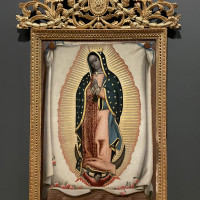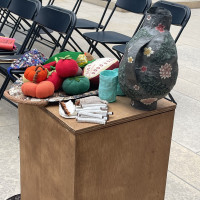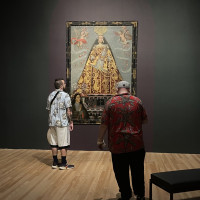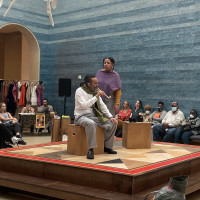Theater-Goers Embrace Latino History and Art
By Oihane Ochoa
Reporting Texas TV
AUSTIN, Texas – Paintings on display at the Blanton Museum of Art inspired a play, and visitors this month have the opportunity to see it performed in the same space.
The exhibition Painted Cloth: Fashion and Ritual in Colonial Latin America includes a collection by Mexican painter Miguel Cabrera titled “Casta.”
These artworks show family scenes of interracial marriages between Amerindians, Spaniards and Africans, and the different combinations that emerged from them: Mestizo, Moorish, Coyote. Many of the paintings that make up the exhibition are on loan from international museums.
The exhibition’s curator, Rosario Granados, said this creates a unique opportunity to contemplate the pieces by artists from around the world.
“Even though the Spanish crown wanted the people to live separately, individuals always found a way to mix and enrich their cultures with the influence of each other,” Granados said.

Adrienne Dawes wrote a play, also titled “Casta,” which the Salvage Vanguard Theater is performing Oct. 20-30. Salvage is a non-profit company that promotes art in Austin.
An American Sign Language interpreter will assist with the performance on Oct. 29. Seating is limited.
The actors wear costumes inspired by 18th century society and use puppets to represent the children, which facilitates the performance of the play in different cities.
The idea for the play came about in 2016 when Dawes the author discovered the paintings and then explored different artistic possibilities over the years. Creators have been working to perfect it to finally be able to premiere it this past week in Austin.

The goal of both the exhibition and the work is to bring to Austin a part of history that has had direct consequences for a large part of today’s population. It is the origin of the convergence of races that we know today.
“The painting reveals an interesting part of our history in Mexico. Texas was Mexico back in the day, so there is a lot to look at in addition to the way Latin folks in the USA as well as Black folks and how their stories intertwined,” Dawes said.
“I would love if people could have a great conversation about mixed race identity and how that legacy of racism is still reflected in our contemporary times,” she said.
In addition, Granados said the experience invites viewers to reflect on their origins and identity.
“These paintings were made at the end of the 18th century as a way of classifying people, but we continue to have an obsession with determining where we came from. It is not possible to reduce our identity to a little box that we can check,” Granados said.



